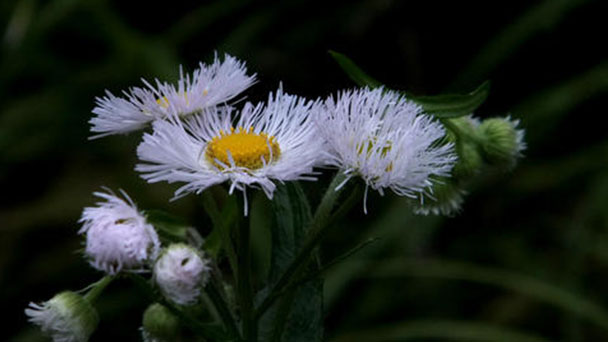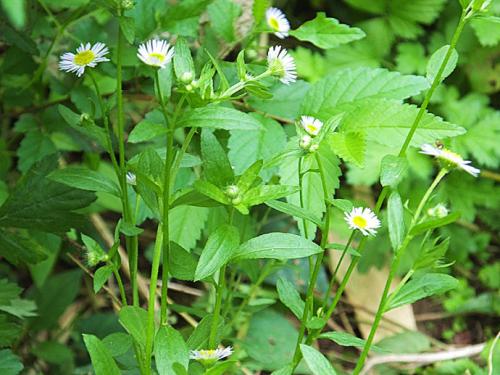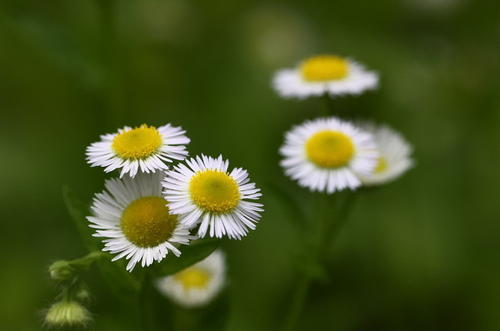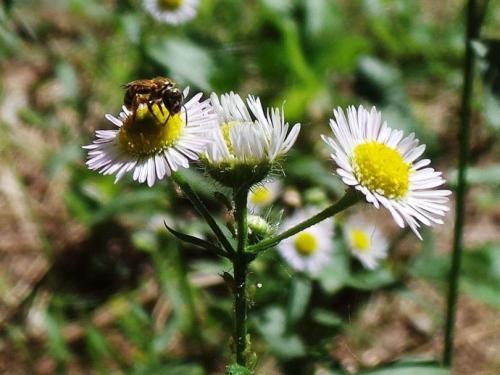Daisy Fleabane (Erigeron Annuus) Profile
Written by admin
Oct 28 2021

Daisy Fleabane, scientific name Erigeron annuus, is an annual or biennial herb, 30-100cm tall. Daisy Fleabane stem is erect, distally branched, the whole plant is short bristle of the upper curve.
Daisy Fleabane Picture

Daisy Fleabane Characteristics
Daisy Fleabane stem is erect, 30 -- 100 cm high, stem and leaves have just overcast hair, density varies, basal leaves ovate or ovate-lanceolate, 4 -- 15 cm long, 1.5 -- 3 cm wide, tip pointed or blunt, the base narrow into a pteriole, the edge of coarse teeth; Cine leaves are lanceolate or linear-lanceolate, 1 -- 9 cm long, 0.5 -- 2 cm wide, apically acute, margin toothed, regular or irregular, short or sessile; Upper leaf of daisy fleabane is mostly linear, entire; Leaf margin is ciliate.
Inflorescences ca. of Daisy Fleabane are 1,5 cm in diameter, arranged in cymbose or paniculate forms; Involucral bracts are hemispherical, involucral bracts 3-layered; Margin is ligulate, conspicuous, 2-multilayered, female, ligulate linear, white or purplish-blue; Disk flowers are tubular, bisexual, yellow.
Achenes of Daisy Fleabane are lanceolate, oblate, crested heteromorphic; In female flowers, there is a very short membranous corolla joined into a ring; The outer crown hairs of bisexual flowers are very short and scaly, the inner layer is strigose, 10 -- 15.
Daisy Fleabane Habits
Daisy Fleabane is an annual or overyear (biennial) herb. They are fond of fertile and sunny soil and can grow in dry and poor soil.
Daisy Fleabane generally grows along roadsides, open fields or hillsides.

Daisy Fleabane Propagation
The seeds germinate in early spring or autumn, blossom in summer, bear fruit in autumn, and propagate by seed.
Daisy Fleabane Distribution
Daisy Fleabane is native to North America, in addition to Xinjiang, Inner Mongolia, Ningxia, Hainan, northeast, north, central, east, south and southwest China and other places are distributed.
Daisy Fleabane is distributed in the Americas and the provinces of Hubei, Jiangsu, Sichuan, Fujian, Anhui, Henan, Xizang, Jiangxi, Hunan, Shandong, Hebei, Jilin and other places, growing in the area of 200 meters to 2,200 meters above sea level, generally born in the roadside wilderness and hillside wasteland, has not been artificially introduced and cultivated.
Daisy Fleabane's species invasion hazards
Because of its strong reproductive ability and adaptability, Daisy Fleabane has been included in the list of alien invasive species and has been added to the pest system of Chinese agriculture. Daisy Fleabane often harms economic plants such as autumn harvest crops, wheat, fruit trees, tea and mulberry, and can also invade grasslands, pastures and nurseries, with large amounts of occurrence and heavy harm. Daisy Fleabane is also the host of the ground tiger.

Read Next:
Top 10 Most Beautiful Roses in the World
Top 10 Most Beautiful Flowers in the World
26 Best Autumn Flowers to Plant for Fall Color in Garden
Latest Updated
- Benefits of Bugleweed - 7 Science-backed Health Benefits
- Bugleweed Dangers & Side Effects - Is It Poisonous?
- How to Plant Evergreen Trees - What You Should Know
- When to Plant Evergreens - Grow Guide for Evergreen Trees
- 12 Wonderful Evergreen Shrubs for Your Garden
- 12 Popular Evergreen Plants with Pictures for Beginners
- When And How To Prune A Lilac Bush Like a Pro
- How to Grow & Care for Lilac Vine (Hardenbergia Violacea)
- Japanese Lilac Tree (Syringa Reticulata) Care & Propagation Guide
- Shumard Oak Pros and Cons - What to Know
Popular Articles
- Winter maintenance of Antirrhinum Majus
- How to Grow Terminalia Mantaly Tree
- How to Grow and Care for Crossostephium Chinense
- How to grow Antirrhinum Majus in spring
- Peristeria Elata (Dove Orchid) Profile: Info & Care Guide
- Underwatered Snake Plant (Sansevieria Trifasciata) - Signs And How To Fix
- How to Care for Brazilian Jasmine Plant (Mandevilla Sanderi)
- How to Grow & Care for Graptopetalum Purple Delight in Summer
- Rosa Chinensis (China Rose): Plant Growing & Care Tips
- How to Care for Baby Sun Rose (Aptenia Cordifolia)